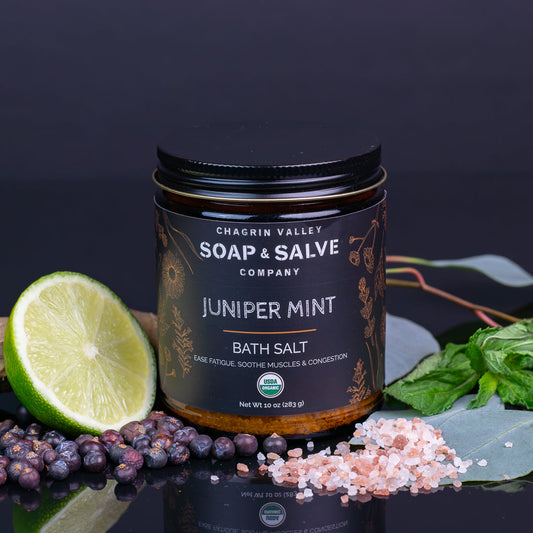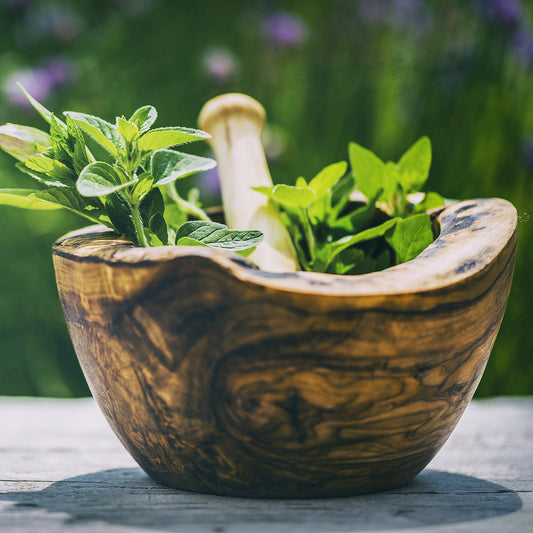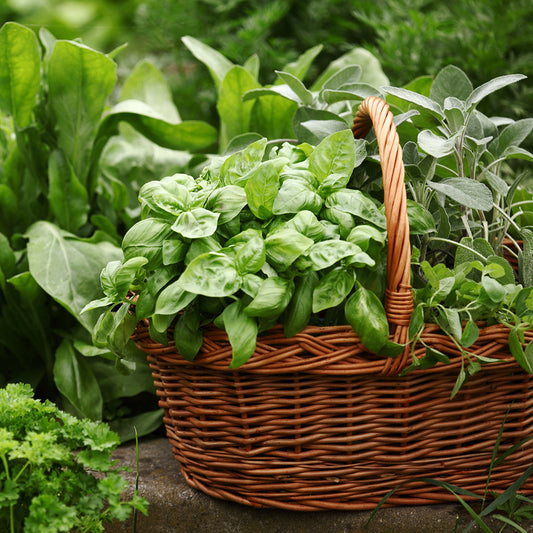Herbal Bath Tub Tea Recipes
These days I find nothing more relaxing and enjoyable than a soak in the tub -- it is my act of self-love. My favorite addition to my tub has always been organic herbs and botanicals.
 Herbs and botanicals are great all on their own but you can easily combine them with great skincare additives most of which can be found in your kitchen cupboards.(Find some "Get Creative" recipes below!)
Herbs and botanicals are great all on their own but you can easily combine them with great skincare additives most of which can be found in your kitchen cupboards.(Find some "Get Creative" recipes below!)
There are three different ways you can prepare a simple herbal bath using Chagrin Valley Bathing Herbs depending on your preferences.
(1) Throw a handful of herbs directly into the hot bathwater. When I was younger I absolutely loved immersing myself in bathwater filled with floating herbs and botanicals.
To be honest, at the wonderful age of 67, the act of cleaning the tub is NOT my idea of self-love. Also, there may be bits of botanicals remaining on your body and in your hair. Though I still enjoy my herbal baths, the herbs are now neatly packed in a muslin bag!
(2) For a stronger herbal bath, brew some herbal tea in a pot, and then add the steeped tea to the bathwater.
- Fill a pot with about 2 to 3 quarts of water, heat to almost boiling, and remove from the heat
- Put a handful of your herbal mixture (about 1/4 to 1/2 cup) into the pot
- Keeping the pot covered so the natural essential oils from the herbs don’t evaporate
- Allow the herbs to infuse for 20 minutes or longer
- Strain the liquid and add it directly to your tub
- This method works best if you are using herb roots, barks, or other woody parts of a plant. It is actually called a decoction.
(3) Make a "tea bag" by filling a cloth, cheesecloth, muslin bag, or even a clean sock or nylon stocking with a small handful (about 1/4 to 1/2 cup) of the herbal bath tea. All of our teas include a cotton muslin bag and this is MY favorite method!
Every bathtub is different -- Start out with the smaller amount and see how it feels. The idea is NOT to fill up a bag with bathing herbs. A larger bag allows water to flow more freely around the herbs!
 It is NOT true that if a small amount works well, then a large amount will work even better!
It is NOT true that if a small amount works well, then a large amount will work even better!
To Use the Tea Bag
- Tightly close the top and ...
-
Add the herbal tea bag to your tub
- Hang the bag from the faucet and allow warm water (the temperature that is comfortable for you!) to run through the bag while the tub fills. When the tub is full, remove the pouch from the spout and let it float in the tub, continuing to steep in the bathwater.
-
OR place the bag in the bath under warm running water (the temperature that is comfortable for you!) until the tub fills and then let it float in the tub, continuing to steep in the bathwater.
- Hang the bag from the faucet and allow warm water (the temperature that is comfortable for you!) to run through the bag while the tub fills. When the tub is full, remove the pouch from the spout and let it float in the tub, continuing to steep in the bathwater.
- Squeeze the bag to release the botanical essence.
No matter which method you choose . . . slip into your herbal oasis and relax for 15 to 20 minutes.
One note: An herbal bath is a time to relax the body not cleanse it -- no soap or bubble bath! If you need to wash take a shower before. To get the full benefit from an herbal soak, simply towel dry when you leave the tub.
When You Are Finished Bathing:
After you have finished your herbal bath, toss the contents of the tea bag into the garden or compost, or reuse them.
The first time you use the herbal tea bath bag, it will be the most potent. However, the herbal bag can be reused if you hang the bag of wet herbs and allow them to completely dry in between baths. They can be reused 2-3 times before you won’t reap the benefits and will need to start a new bath tea bag.
TIP: If you are using bath tea that is made up of only herbs and other botanicals, after using in your tub place the whole damp bag in the dryer to add a fresh scent (works great with towels and linens).
Simple Bath Tea Recipes
Use our Chagrin Valley Bathing Herbs or make your own blend. Any combination of herbs that speaks to you is great for an herbal bath. Don't hesitate to mix and match herbs and botanicals to make combinations that you need or want. For more information on creating your own blends read "How To Make and Use Bathing Herbs."
Get Creative
Herbal bath teas are perfect all on their own but anytime you prepare an herbal bath you can combine bathing herbs with other great skincare additives most of which can be found in your kitchen cupboards. Just prepare your herbal bath tea and add a favorite ingredient.
Some additives can make your tub slippery--so be careful!
Add Salts
 Bath Salts are known for their health-enriching minerals and therapeutic properties.
Bath Salts are known for their health-enriching minerals and therapeutic properties.
A salt bath can help improve circulation, soothe irritated skin conditions, ease muscular pain, joint stiffness, arthritis, back pain, or muscle cramps.
Add 2 - 8 tablespoons of sea salt, or try one of our organic bath salts, to your herbal bath
Add Milk
Milk contains lactic acid, which is packed with skin softening properties that leave skin feeling smoother. The lactic acid in milk acts similarly to the alpha hydroxyl acids found in expensive skin creams, which dissolve proteins that bind dead skin cells together for gentle exfoliation.
As you soak milk fats and proteins help to hydrate the skin and retain moisture to leave your skin smooth and soft. Milk baths are also great for soothing irritated skin and minor sunburn.
Add 1 - 2 cups of whole milk to your herbal bath
Add Oatmeal
Oatmeal baths are great to soothe sensitive or irritated skin. They are naturally hydrating and release milky emollients that can calm itchy skin conditions.
To avoid turning your bath into a giant bowl of oatmeal, add 1 cup of organic oatmeal or 1/2 cup of organic oat flour to your herbal bag. Or make a separate bag of just oatmeal and add it to the tub as it is filling.
Add Bath Oil

Herbs and oils have long been combined in a therapeutic bath to relax the mind, soothe sore muscles, and promote soft supple skin. Add extra moisture and softness to your skin by adding oil to your herbal bathwater.
Take 1- 2 tablespoons of your favorite oil, like coconut or olive, or try one of our organic bath oils
Add oil to your herbal bath as the water is filling.
(BE careful--the tub may be slippery)
Add Honey
Honey has been used topically as a healing agent for centuries! Adding honey to your bath will moisturize, soften, and soothe dry skin.
Honey can help deep clean pores while adding moisture to parched skin. Honey, a natural humectant, moisturizes, and softens skin as you soak. Honey can help soothe irritated skin and also has skin-smoothing benefits thanks to its amino acids and antioxidants.
Dissolve 1/4 to 1 cup of honey in hot water. Add the honey water to your herbal bath as the water is filling.
While for some women prone to yeast infections adding honey to bath water may pose a problem, others have found it helpful. Know your own body!
Add Lemon
Added to the bath, fresh lemons, rich in vitamin C, not only impart a lovely scent but they also help to balance skin oil production, brighten skin, and cleanse and tighten pores.
Lemon baths can help relax sore muscles and the scent can help uplift your spirits.
Fill up your bathtub with warm water. Slice up 3-4 lemons and place the slices in your bathwater. Allow the lemons to soak in the water for about five minutes. Step in, relax, and enjoy!
Add Essential Oil
 Adding your favorite essential oil or essential oil blend is a great way to create a very aromatic and therapeutic bath.
Adding your favorite essential oil or essential oil blend is a great way to create a very aromatic and therapeutic bath.
Never add essential oils directly to the bathwater! The problem -- essential oils do not dissolve in water. If you simply drop some essential oil in your tub, the drops will just sit on top of the water and will not disperse throughout the bathwater. As you climb into the tub, small drops of concentrated undiluted essential oil can stick to your skin which may cause irritation for some.
To add essential oils mix them in a carrier oil first, like olive or sunflower.
Start small--for a single bath, add 3 to 12 drops of essential oil in a tablespoon (15 ml) of carrier oil. For the best aromatic bath, fill the tub, turn off the water, add your carrier oil/essential oil blend, and then stir the water before climbing in to help circulate oils around.
Using ready-made Aromatherapy Bath Oils is another option.
A Few Important Notes:
Despite the many advantages, a warm bath may not be recommended for everyone.
- Do not use very hot water
- Do not soak for more than 15-20 minutes each time
- If you have a heart condition or any medical condition, consult with your doctor before beginning a new bathing routine
- If you are pregnant, please discuss baths with your doctor or midwife
- Keep some cool drinking water nearby
- Even a healthy person may begin to feel dizzy, or not well when taking a bath. If this happens, slowly get out, rest, and drink some water as you may be dehydrated. If you do not feel better soon, please seek medical advice.
For information on creating your own bath teas, read our blog "How to Make and Use Herbal Bath Teas"






